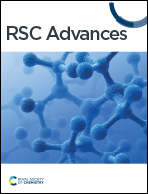An amorphous MgF2 anti-reflective thin film for enhanced performance of inverted organic–inorganic perovskite solar cells†
Abstract
The effective control of light plays an important role in optoelectronic devices. However, the effect of anti-reflection thin film (ARTF) in inverted perovskite solar cells (PSCs) (p-i-n) has so far remained elusive. Herein, MgF2 ARTF with different thicknesses (approximately 100, 330, and 560 nm) were deposited on the glass side of FTO conductive glass substrates by vacuum thermal evaporation. The results of reflectance and transmittance spectroscopy show that approximately 330 nm MgF2 ARTF can reduce reflectivity and increase transmittance on FTO conductive glass substrates. The results of SEM, XRD, and AFM show that the surface of amorphous MgF2 ARTF possesses a lot of nanoscale pits. The effect of the MgF2 ARTF on the performance of inverted perovskite solar cells (PSCs) (p-i-n) was investigated. The power conversion efficiencies (PCE) of inverted PSCs without and with MgF2 ARTF are 18.20 and 21.28%, respectively. The significant improvement in PCE of the devices with MgF2 ARTF is caused by the improvement in short-circuit current density. The stability results of the devices show that the PCE remains above 70% of the initial PCE after 300 h illumination.



 Please wait while we load your content...
Please wait while we load your content...